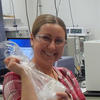Taking Measure
Just a Standard Blog

Capillary electrophoresis was used in the certification of SRM 2391d. Here's me loading samples onto a genetic analyzer.
How do you solve a crime using DNA? First, you have to find biological evidence — such as blood, other bodily fluids, or maybe just a few skin cells that might be related to the crime. Then you can try to generate a DNA profile from that evidence. That is a genetic fingerprint, and no two people, other than identical twins, share it.
Once you have a DNA profile of a suspect, you can look for someone who matches it. After that, you’ll still have a lot of work to do to solve the crime, but that first step of generating the profile is crucial. If that’s not done carefully, you won’t get accurate results.
To help crime labs ensure that their DNA profiling is accurate, NIST produces a human DNA standard. Becky Steffen, a forensic DNA scientist at NIST, has been working to prepare the latest version of this standard, which was released last week. In this Q&A, Steffen describes the standard and explains why it’s so important.
What is the human DNA standard?
This standard is made up of DNA, the same kind of DNA you have in your cells. But what’s special about it is that we’ve measured and analyzed this DNA very carefully. When labs purchase this standard, they get the DNA itself, and they also get a DNA profile that we’ve developed so they know it’s accurate. We also send them lots of other data, including the genetic sequences for locations in the DNA that forensic scientists would analyze. So it’s physical material plus information about that material that we guarantee is correct. These things together can be very useful.

Who uses the DNA standard, and how?
DNA labs use this standard to make sure their instruments and methods are working properly. To do that, they take our standard DNA and run it through their processes to produce a DNA profile. Then they’ll compare that profile to the one that we certify as correct. If the two profiles match, they know their methods are working properly. If they don’t match, then they know something is wrong, and they’ll need to fix it before they work on real evidence from a crime scene.
So, this is all about quality control. And that’s important because you don’t want to convict someone who is innocent or let someone guilty go because there was something wrong with your process. Accredited crime labs are actually required by law to do this on a regular basis. Also, if questions come up in court about quality control, the expert can say, “We’ve properly calibrated our instruments using the NIST standard.”
Where did the DNA in this standard come from? Is it yours?
No, it’s not mine. We extracted three DNA samples from the blood of three different individuals that we bought from a blood bank. The people who donated the blood gave full consent, and we don’t know who they are because it’s all been anonymized, but we do know that the three samples are from one female and two males. We also have a mixture of two of those samples as well as cells that we bought from a cell bank spotted onto paper. So, the standard has four unique profiles and a mixture.
Tell me about your role in creating this standard. What did you do exactly?
It wasn’t just me; this was a huge team effort. We extracted the DNA from the blood samples, quantified and diluted it, and sequenced all the forensic markers. Then we distributed the DNA into the tubes you get when you purchase the standard. We worked with statistics experts to come up with a testing scheme to ensure that all the tubes contain the same amount of DNA and produce the same exact answers when analyzed. We also periodically tested the DNA to make sure it produces the same profile over time.

Why do you find this work interesting or meaningful?
I think we here at NIST play an important role in the forensic community. A LOT of work went into creating this standard, so the fact that the final product is now for sale is something that our whole team worked really hard on and is proud of.
DNA technology is always changing, with new techniques coming out, and new forensic markers—the research is just astounding. Being a part of that is really exciting for me. But more importantly, this standard is helping investigators solve crimes and keep people safe by providing new information to crime labs that they may not have had access to before.






Thanks for the article